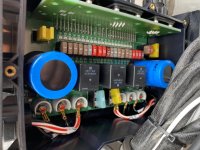rcarsey
Well Known Member
I was recently troubleshooting an alternator-out/intermittent issue. In the process of tracing things, I examined the Rotax fusebox mounted on the firewall. During building, I never bothered to open it or even look inside.
Below is a photo of what I found. The engine has 3 hours on it. The two fuses pictured, (I believe, though haven't consulted Rotax manuals yet) protect Regulator A and Regulator B output. It's not clear to me what would have happened if both fuses fell out simultaneously.
I have pushed them back in (with minimal force I may add), and added generous beads of hot glue to make sure they don't come out. I would advise all owners to take a look through the protective frosted plastic next time they have the top cowl off.
Below is a photo of what I found. The engine has 3 hours on it. The two fuses pictured, (I believe, though haven't consulted Rotax manuals yet) protect Regulator A and Regulator B output. It's not clear to me what would have happened if both fuses fell out simultaneously.
I have pushed them back in (with minimal force I may add), and added generous beads of hot glue to make sure they don't come out. I would advise all owners to take a look through the protective frosted plastic next time they have the top cowl off.





